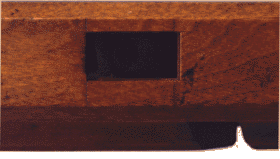
All the planes in this exhibit are made of yellow birch, the most popular wood for making planes in colonial America. Later planemakers found beech to be a better wood for planes. In general, the fit and finish of Chelor's planes was good for his time. Though the American planemakers did not produce as high a quality tools as their English counterparts, one must remember that the colonies were poor and there was a high demand for any decent tools.
The blades are thinner than one would expect from a wooden plane. Again, this is typical of the period. Steel was in extremely short supply. Iron on the other hand was pretty common. At this time there were three methods of making steel. The best method, cast steel, was still in its infancy, and while the resultant steel was of extremely high quality, it wasn't common or cheap enough to warrant using in tools. Most steel was blister steel, made by laboriously hammering the impurities out of strips of wrought iron. A thin steel tip would then be forge welded to a wrought iron blade body. The third method was to case harden the iron so it had a layer of steel on it. Chelor probably bought his blades from English and American sources and filed and fit them to his plane bodies.
All Chelor plane bodies are of standard length and, from a design perspective, they do not differ significantly from any other planes of the period. These were not high tech inventions; planes were commodity items that were essential for woodworkers and joiners.
Nicholson's will left Chelor "one third part of my timber"; dried timber ready to be made into planes. Part of the annual activity of the shop would have been finding good yellow birch trees, cutting them down, and sawing them into boards of a suitable size for planes. The boards would be stickered (stacked with sticks between the boards) so that the wood would dry. The standard for drying is 1" per year. The plane bodies are about three inches thick so the wood would have sat for three years. If Nicholson had not left Chelor timber ready to use Chelor would have had to wait years before he could start making planes and set up a business.
The wood would then be sawn into blanks many planes long so that the sides and grooves could be planed in. This was brute force work and while planing is not totally unskilled it certainly was a waste of skilled labor. This work would therefore have been done by less skilled shop workmen or day laborers. Then the planes were cut to length and their chamfers planed on. The end grain was then planed smooth and the plane was scribed with layout marks for cutting the throat and filling the blade. We can still see the layout lines on some of the planes.
The next two steps require skill. First, the throat would be chiseled out. Finally, a blade and wedge would be fitted. This last step is very skilled and here Chelor would be doing most of the work himself. The trick is to create a plane where the blade fits tightly against the wood and where the wedge holds the blade tight all along the throat. The blade has to be able to cut a thin shaving without clogging. After the plane was tested, the front would be stamped with Chelor's name and the location.
The tool marks and layout lines that were left on the finished piece show another aspect of American craftsmanship. In a society of shortage, where there was a huge demand for tools and a limited number of people who could make them, the goal was producing a decent and inexpensive tool. This is a tradition that has continued on today. American has long been known for its ability to produce serviceable goods inexpensively, as opposed to high quality goods for the rich. We are a country of Fords, not Rolls-Royces.
In Francis Nicholson and Cesar Chelor we see a typical colonial enterprise. All the work was done by hand, so production and distribution were limited. By the 1820's, planemaking and toolmaking was increasingly done by larger workshops that eventually turned to the factory system. This was the beginning of the Industrial Revolution in America. In this period, machines were being invented and the lone planemaker could not compete. Greater ability to produce also created the need for a wider market to sell the goods. Better roads and commerce made these markets possible, and allowed regional companies to dominate the market. This process continued and by the American Civil War the emergence of large factories with national marketing campaigns totally dominated the tool industry. Ironically, the Revolution that created this industry also made it possible to mechanize the making of furniture. As a result, we see the demand for hand planes decline. Thousands of craftmans were replaced by hundreds of power planers, molders and shapers.
